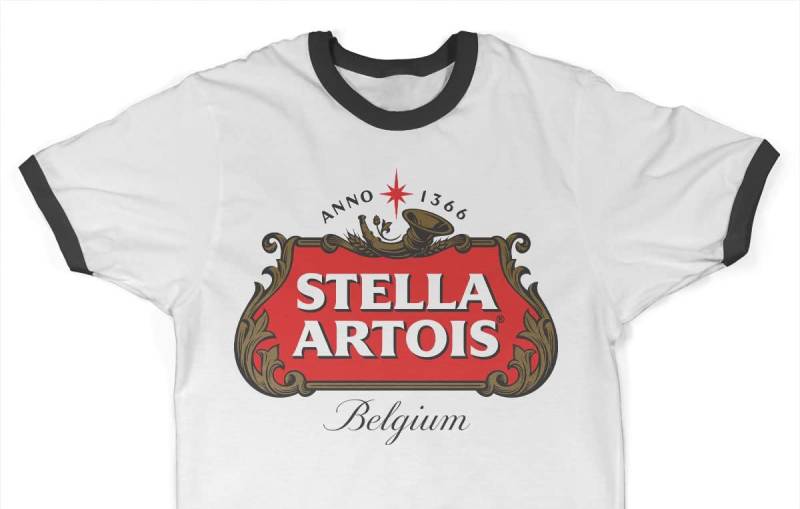The Stella Artois Logo History, Colors, Font, And Meaning

Imagine lifting a chalice, the glint of gold catching your eye before a sip of premium lager meets your lips. This isn’t just any beer—this is to hold the legacy of centuries in your hand.
Stella Artois, a name echoing through the taverns of time, adorns each glass with its unmistakable logo. But this emblem transcends mere graphics; it’s a tapestry woven from the threads of Belgian brewing heritage and the artistry of design.
In this exploration, we delve into the visual saga carved by the Stella Artois logo—from its birth in the Den Hoorn Brewery to its global acclaim.
The horn, ever-present, whispers tales of tradition and quality, while the beer emblem‘s every curve and hue unravels the story of a brand identity sculpted to perfection.
By journey’s end, one will grasp not only the elements that compose such an iconic motif but also why this sigil stands as a benchmark in the realms of beer label design and branding elements—a timeless centerpiece in the advertising campaigns of the bustling beer industry.
The Meaning Behind the Stella Artois Logo

Symbolism and Elements: The Stella Artois logo is laden with symbols that reflect its legacy and authenticity. The prominent horn, often referred to as the “Horn of Plenty,” signifies abundance and quality.
The presence of a star, which literally translates to ‘Stella’ in Latin, is another central component. This celestial body not only represents the brand’s name but also embodies excellence and distinction in brewing.
The Emotional Connection: Visual cues are powerful tools for evoking emotions and sentiments.
When you glance at the Stella Artois emblem, the intricate design elements aim to evoke feelings of nostalgia, trust, and premium quality. Its refined artistry is a testament to the brewery’s commitment to sophistication and the finer things in life.
The History of the Stella Artois Logo

Origins and Evolution: Dating back to the 14th century, the Stella Artois brand boasts a rich history. The logo, too, has seen evolutions that mirror its journey.
Originally, the brand was identified by its authentic brewing methods and the town of its origin, Leuven. Over time, as the brand grew in prestige and recognition, the logo was refined to encapsulate its essence and values more distinctly.
Revisions and Modern Adaptations: The Stella Artois logo underwent tweaks and changes, especially in the 20th and 21st centuries. Each revision aimed to modernize its appearance while retaining its iconic elements.
The challenge was to harmonize historical reverence with contemporary design sensibilities, and Stella Artois navigated this with elegance.
The Colors of the Stella Artois Logo

Red and White Palette: Predominantly, the Stella Artois logo employs a crisp red and white color scheme. The red signifies passion, energy, and warmth, resonating with the brand’s commitment to brewing excellence.
Meanwhile, the white accentuates purity, clarity, and integrity, reflecting the brand’s promise of uncompromised quality.
Subtle Hues and Undertones: In various adaptations, especially in promotional materials, the logo might be seen with subtle shades, highlights, or gradients. These nuances further emphasize the logo’s dimensions and the brand’s attention to detail.
The Font Used in the Stella Artois Logo
Classic and Timeless: The typeface in the Stella Artois logo perfectly marries tradition with readability. Its serif font exudes a classical charm, reminiscent of old-world elegance, yet remains lucid and approachable.
Adaptations and Variations: While the main logo retains its iconic font, various marketing campaigns and limited editions have seen subtle tweaks in typography to align with specific themes or messages. Yet, the core essence remains unchanged, ensuring brand consistency.
Influence on Pop Culture
Media and Collaborations: The Stella Artois logo, owing to its iconic design, has made appearances in various forms of media, from movies to art collaborations. Its distinct design has made it a favorite for product placements, enhancing its cultural relevance.

Fashion and Merchandising: Given the emblem’s chic appeal, it’s no surprise that Stella Artois-inspired fashion items, from t-shirts to hats, have found their way into the wardrobes of fans and fashion enthusiasts alike. The logo, in this context, becomes more than a brand marker; it’s a style statement.
Impact on Design Principles
A Lesson in Branding: The Stella Artois logo serves as an exemplary case study for design students and professionals. Its balance of history, symbolism, and modernity offers valuable insights into branding and identity creation.
Influence on Contemporary Designs: Many modern logos, especially in the beverage industry, draw inspiration from the Stella Artois design ethos. Its influence can be seen in the way brands integrate historical elements, color choices, and typography to create impactful visual identities.
FAQ On The Stella Artois Logo
What is the history behind the Stella Artois logo?
The Stella Artois logo carries the heritage of Leuven’s Den Hoorn Brewery, which dates back to 1366. The horn, harking to the brewery’s name, symbolizes tradition.
Over the years, the logo evolved, incorporating elements that reflect its Belgian origins and its premium lager status.
How has the Stella Artois logo changed over time?
Through the ages, the logo witnessed iterations that subtly enhanced its visual appeal while honoring its core identity.
The iconic horn, a steadfast in its design, saw stylistic refinements. Colors and typography updates ensured modernity without forsaking its historical essence.
What does the Stella Artois logo represent?
It represents a blend of rich brewing tradition and contemporary elegance. Every aspect, from the opulent gold rim to the bold red backdrop, echoes quality and craftsmanship. It is a beacon of the brand’s commitment to producing a lager that’s synonymous with sophistication.
Why does the Stella Artois logo use a horn?
The horn directly links to the brewery’s origins, named ‘Den Hoorn’. This emblematic feature anchors the logo to its lineage, while casting an image that’s distinguishable at a glance—a nod to history that graces each label and advertising endeavor.
Is the Stella Artois logo considered effective for branding?
Absolutely. Its unmistakable look stands out amid the clutter of beer emblems. The horn symbol and elegant typography exude premium quality, resonating with the brand’s positioning.
It is an entity that commands attention and signifies a high standard in the international brewing landscape.
What colors are used in the Stella Artois logo and why?
Predominantly, it employs gold, red, and white. Gold signifies luxury, red speaks to passion, and white balances with purity. These trademark colors are chosen to represent the beer’s regal quality and the passionate brewing process that goes into each bottle.
How important is the Stella Artois logo for marketing campaigns?
Invaluable. It is often the centerpiece of stellar advertising graphics, embodying the brand’s identity.
It plays a pivotal role in the visual storytelling that connects consumers to the Stella Artois experience—a strategy that’s crucial for maintaining its status as a leading lager label.
What makes the Stella Artois logo different from other beer logos?
It favors an aura of vintage charm combined with sleek modernity. Its distinctly European flair sets it apart from other beer brands. The horn, a mark of originality, ensures instant recognition, and its artistic finesse makes it not just a logo, but a symbol of a legacy.
Can the Stella Artois logo be found on merchandise?
Indeed, the logo adorns a variety of merchandise. From the iconic chalice and apparel to various collectibles, its branding elements transition seamlessly onto products, allowing enthusiasts to own a piece of the brand’s esteemed iconography.
What impact does the Stella Artois logo have on consumer perception?
The logo is a defining factor in consumer perception—often seen as a guarantee of quality and elegance.
When consumers spot the emblem, they expect a beverage experience that is both upscale and steeped in brewing mastery—associations that have been carefully cultivated over decades.
Conclusion
Crafting narratives in design, distilling essence—like a brewer with hops, water, and barley—culminates in a symbol transcending time. The Stella Artois logo encapsulates such an alchemy of history, quality, and artistry.
To hold a chalice adorned with that iconic horn is to cradle a story in one’s grasp—a story spun from Belgian heritage and the looms of high craftsmanship. This tale, though conveyed through a mere emblem, reverberates with the resonance of a premium lager, esteemed by connoisseurs worldwide.
In the dance of design elements and trademark colors, one uncovers more than a visual identity: a promise—a promise of enjoying a beverage brewed with the precision afforded by centuries of knowledge, spoken silently yet profoundly through that very same logo.
Invariably, the emblem serves as a beacon within the beer industry, not through loudness but through a refined whisper of distinction. Thus, as the froth settles in the glass, remember: it’s not just a drink; it’s a chapter of legacy cradled in your hands.
If you enjoyed reading this article about the Stella Artois logo, you should read these as well:
- Heineken Advertising Campaigns On Print And Tv
- Awesome Bottle Mockups For Designers (Free and premium)
- The Pepsi Logo, the old, the new, its meaning and history
- Luxury Fonts: What Font Does Dior Use? - 17 May 2024
- The Dos Equis Logo History, Colors, Font, And Meaning - 16 May 2024
- Purple Color Palettes Fit for Royalty - 16 May 2024









